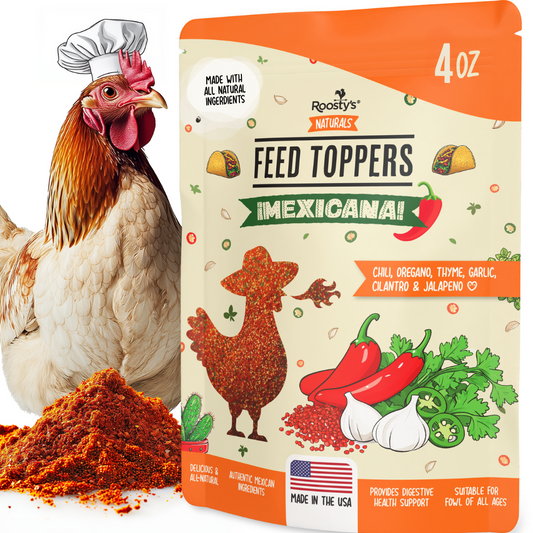
Light for Chicken Coop: Energy-Efficient Lighting

Setting up your chicken coop is all about creating the perfect conditions for happy, healthy hens.
A light for chicken coop construction is just one of the elements you will need to consider.
Lighting up your chicken coop can help to maximize egg production by creating the right habitat for your chickens. But you need to choose the right light to keep your hens happy and to fit your budget and coop setup.
Energy-efficient lighting, such as LED lights, is the perfect option. It saves energy, and money, comes in a range of colors and intensities, and can be adjusted easily too.
Get ready to light up your coop with this guide to energy-efficient chicken coop lighting.
You'll learn how to choose lights for chicken coop installation, and how to put in a light in a chicken coop too.
The Importance of Efficient Lighting for Your Coop
Just how important is lighting in your chicken coop? Is it really necessary? Putting a light in your chicken coop isn't essential, but it is a choice many chicken owners make.
The main reason to install lights for chicken coop builds is that it boosts egg production.
Darker winter mornings and evenings lower chickens' egg-laying hormones, resulting in fewer eggs. So if your goal is more eggs, you need more light.
Running a light all the time can obviously get a little expensive. Even if it's only one light, the cost can add up.
Fortunately, there are energy-efficient ways to install a light for your chicken coop in winter.
- Use LED lights (they're much more efficient than traditional bulbs)
- Choose solar lights that will recharge during the day
- Set the right lighting schedule using a timer
Maximizing Egg Production with Chicken Coop Lighting
The reason most people choose lights for their chicken coop is to help maximize egg production.
For optimal egg production, chickens should get 14-16 hours of light each day and 8-10 hours of darkness.
This helps to boost the hormones required for egg laying, while allowing them a quiet, dark space to sleep at night.
The pineal gland in chickens and other birds senses changes in light. The gland helps to regulate the chicken's hormones and growth, as well as their behavior.
Using a timer is a popular way of keeping to a good lighting schedule. As well as making it easier, it will also save energy by ensuring the lights go off and on at the right times.
Light isn't the only factor that affects egg production. The breed and age of the chicken are two other factors that make a difference.
Some types of hens have been bred to lay all year. Breeds such as Red Stars and Leghorns will lay all year, even without the addition of winter lighting in the coop.
Winter Lighting Solutions

Most people use chicken coop lights in the winter to help promote egg production. During the rest of the year, the daylight hours are usually enough.
Not all chicken owners choose to use lighting throughout the winter. Some like to give their chickens a rest, at least for part of the season.
By not installing lights for your chicken coop in winter, you can allow your hens a break from laying until spring arrives.
However, if you do want to light up your chicken coop in the winter, there can be several advantages.
As well as helping with egg laying, it can increase the sociability of your chickens. More lighting in winter could even reduce aggressiveness and behaviors such as feather pecking.
To add lighting to your coop, you can suspend a single light off the floor or even use something like string lights.
It's important to be aware of the difference between a normal light and a heat lamp. Heat lamps are something different and they can increase the risk of fire in your coop, so many recommend that they're avoided.
Choosing the Right Light
Selecting the best light for chicken coop lighting doesn't need to be complicated. You may only need one light, or you might choose several smaller lights.
You need to think about the brightness and intensity of the light, as well as its safety. And, of course, energy efficiency is an important factor to consider too.
Size of the coop
The size of your chicken coop will affect your choice of light. A larger coop may need a more powerful light or more than one light.
A smaller coop won't need a bulb with high wattage to provide your chickens with enough light. A 40-watt bulb could be suitable for a coop of around 100 square feet, but you may need a more powerful bulb for a larger coop.
Safety
Safety is always important when choosing lights for your chicken coop. You need lighting that is safe to use in a chicken coop and won't increase the risk of fire.
Your lights should not get hot, as this could increase the risk of fire or hurt your chickens. Make sure your lights are installed safely.
This could mean ensuring that they're off the ground and away from your chickens. LEDs are a safe choice because they're non-toxic, durable, and don't get as hot as incandescent bulbs.
Energy efficiency
If you're thinking about saving energy, LEDs are a good choice for this too. LED bulbs use less energy, so you can save money on running your chicken coop lights.
While LED lights can be more expensive, they also last longer than other bulb types. This means that the cost works out in the end. Another option for energy efficiency is to consider solar-powered lights.
You save energy because they're powered by the sun and they're a great option if you can't run power out to your coop.
The Benefits of LED Lighting
LED lights for chicken coop installation make perfect sense. They have a number of benefits, especially if you're going for energy efficiency.
- Energy efficient - LED lights use less energy compared to fluorescent or incandescent bulbs
- Longer lasting - you can expect some LED bulbs to last for up to 10 years without needing to be changed
- Money-saving - running an LED bulb could cost just a couple of dollars across a whole year
- Safe - LED bulbs are non-toxic and durable, making them a safe choice for your chicken coop
Red Lights for Chicken Coops: What You Need to Know

What about the color of the lights you use in your chicken coop? Should you use a red light for chicken coop lighting, and what are its benefits or drawbacks? Red light is often used in heat lamps but can also be used on its own.
In experiments comparing red, green, and white lights, red and white lights led to earlier egg production, as well as longer and higher peak production and more eggs.
Red light can have other advantages too. It is sometimes used for raising chicks because it means they can't perceive other red things as well. This means they don't notice blood on other chicks as easily, which can reduce pecking.
Installing Lights in Your Coop
Both safety and durability need to come first if you want to install a chicken coop light for winter. It's not necessarily difficult to install your lights, but it may depend on what type of lighting you want to install.
Firstly, choose the right place to install your light. It should be away from any bedding to prevent fire. Suspending it from the ceiling of your chicken coop can keep it away from everything else.
If you have electricity to your coop, you will want to connect your light to your power supply. If you need to do any wiring, you might want to get an electrician involved.
However, you may just need to use a few extension cords to get power to your coop, where you can simply plug in some lights.
Using outdoor-grade power cords is smart if you want to ensure everything is safely installed. Light fixtures will typically come with all that you need to fix them to the surface of your choice.
When you have no electricity for your coop, you can still install lighting. Solar-powered or battery-powered lights are both options you can consider.
These can easily be installed in chicken coops by hanging them up. If you're using solar lights, make sure you put the solar panel in a position where it will get enough sun to charge.
Setting the Perfect Light Timer
Setting a timer for your chicken coop lights will automate them and ensure your chickens get the optimal number of light hours each day. Installing a time is quick and easy, and then you just need to set it.
What should I set the light timer on for my chicken coop this winter?
Of course, the big question is what settings you should choose for your time. Your chickens should have between 14 and 16 hours of light each day.
Ideally, you should extend the light in the morning, not the evening. This helps to ensure your chickens don't become disoriented when the light suddenly shuts off at night.
Make sure you don't give your chickens too much light, because it could have the opposite effect on egg laying than what you desire.
Improve Egg Production with Energy-Efficient Lighting
Give your chickens more daylight hours, and you can boost their egg-laying in the winter.
When you install lights with a timer, you benefit from total automation, which creates consistency and makes things easier for you too.







